Scopolamine
Scopolamine, also known as hyoscine,[9] or Devil's Breath,[10] is a natural or synthetically produced tropane alkaloid and anticholinergic drug that is used as a medication to treat motion sickness[11] and postoperative nausea and vomiting.[14][15] Scopolamine is also the main active component produced by certain plants of the nightshade family, which historically have been used as psychoactive drugs, known as deliriants, due to their antimuscarinic-induced hallucinogenic effects in higher doses.[21] Scopolamine has a number of formal uses in modern medicine where it is used in its isolated form and in low doses to treat:[22][23] It is sometimes used as a premedication, especially to reduce respiratory tract secretions in surgery, most commonly by injection.[34] The pharmacological effects of scopolamine are mediated through the drug's competitive antagonism of the peripheral and central muscarinic acetylcholine receptors.[35][36] In doses higher than intended for medicinal use, the hallucinogenic alteration of consciousness, as well as the deliriousness in particular, are tied to the compound's activity at the M1 muscarinic receptor.[40] Plants naturally containing scopolamine such as Atropa belladonna (deadly nightshade), Brugmansia (angels trumpet), Datura (Jimson weed), Hyoscyamus niger, Mandragora officinarum, Scopolia carniolica, Latua and Duboisia myoporoides have been known about and used for various purposes in both the New and Old Worlds since ancient times.[14][46] The use of this combination in obstetric anesthesiology (childbirth) was first proposed by Richard von Steinbuchel in 1902 and was picked up and further developed by Carl Gauss in Freiburg, Germany, starting in 1903.[17][49] A bush medicine developed by Aboriginal peoples of the eastern states of Australia from the soft corkwood tree (Duboisia myoporoides) was used by the Allies in World War II to stop soldiers from getting seasick when they sailed across the English Channel on their way to France during the Invasion of Normandy.[53] The alkaloid scopolamine, when taken recreationally for its psychoactive effect, is usually taken in the form of preparations from plants of the genera Datura or Brugmansia, often by adolescents or young adults in order to achieve hallucinations and an altered state of consciousness induced by muscarinic antagonism.Historically, the various plants that produce scopolamine have been used psychoactively for spiritual and magical purposes, particularly by witches in western culture and indigenous groups throughout the Americas, such as Native American tribes like the Chumash.[63] In 2009, the Czechoslovak state security secret police were proven to have used scopolamine at least three times to obtain confessions from alleged antistate dissidents.[66] Although poisoning by scopolamine appears quite often in the media as an aid for raping, kidnapping, killing, or robbery, the effects of this drug and the way it is applied by criminals (transdermal injection, on playing cards and papers, etc.)Initially, in human trials, relatively low doses of the muscarinic receptor antagonist scopolamine were found to induce temporary cognitive defects.[76][81][82][83] Scopolamine has been identified as a psychoplastogen, which refers to a compound capable of promoting rapid and sustained neuroplasticity in a single dose.With a precise dosage, the NASA spray formulation has been shown to work faster and more reliably than the oral form to treat motion sickness.[89] Although a fair amount of research has been applied to scopolamine in the field of medicine, its hallucinogenic (psychoactive) effects as well as the psychoactive effects of other antimuscarinic deliriants haven't been extensively researched or as well understood compared to other types of hallucinogens such as psychedelic and dissociative compounds, despite the alkaloid's long history of usage in mind-altering plant preparations.

Hyoscine butylbromideHyoscine (disambiguation)hyoscyamineThe Devil's BreathDrugs.comMedlinePlusLicense dataDailyMedPregnancycategoryRoutes ofadministrationBy mouthtransdermalophthalmicsubcutaneousintravenoussublingualrectalbuccaltransmucosalintramuscularDrug classAntimuscarinicDeliriantAntiemeticAmnesticATC codeA04AD01N05CM05S01FA02Legal status℞-onlyPharmacokineticBioavailabilityMetabolismCYP3A4Elimination half-lifeExcretionKidneyIUPAC nameCAS NumberIUPHAR/BPSDrugBankChemSpiderChEMBLPDB ligandCompTox DashboardECHA InfoCardFormulaMolar massSMILESnaturalsyntheticallytropane alkaloidanticholinergicmotion sicknesspostoperative nausea and vomitingsalivatransdermal patchacetylcholinenervous systemanesthesianightshade familypsychoactivedeliriantsrecreationaloccultScopoliaHyoscyamus nigerWorld Health Organization's List of Essential Medicinessea sicknessscuba diversGastrointestinalbiliaryradiologyendoscopyIrritable bowel syndromeClozapinedroolinginflammationpremedicationrespiratory tractsecretionssurgeryinjectionblurred visiondilated pupilsglaucomabowel obstructionbreastfeedingbreast milksecretionDry mouthAnhidrosisTachycardiaBradycardiaUrticariaPruritusConstipationUrinary retentionHallucinationsSeizuresAnaphylactic shockreactionsDyspneaErythemaMydriasisDrowsinessDizzinessSomnolencePhysostigmineblood–brain barriercentral nervous system depressionsupportive treatmentgastric lavageemesisArrhythmiaPhotophobiaparadoxical reactionCheyne–Stokes respirationSkin reddeninggastrointestinal motilitysubcutaneouslyin the eyeintravenouslyantagonismmuscarinic acetylcholine receptors